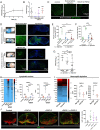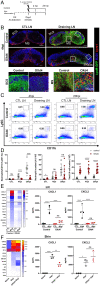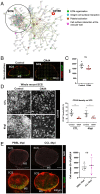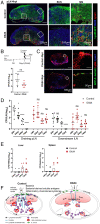Lymph-derived chemokines direct early neutrophil infiltration in the lymph nodes upon Staphylococcus aureus skin infection
- PMID: 35914162
- PMCID: PMC9371737
- DOI: 10.1073/pnas.2111726119
Lymph-derived chemokines direct early neutrophil infiltration in the lymph nodes upon Staphylococcus aureus skin infection
Abstract
A large number of neutrophils infiltrate the lymph node (LN) within 4 h after Staphylococcus aureus skin infection (4 h postinfection [hpi]) and prevent systemic S. aureus dissemination. It is not clear how infection in the skin can remotely and effectively recruit neutrophils to the LN. Here, we found that lymphatic vessel occlusion substantially reduced neutrophil recruitment to the LN. Lymphatic vessels effectively transported bacteria and proinflammatory chemokines (i.e., Chemokine [C-X-C motif] motif 1 [CXCL1] and CXCL2) to the LN. However, in the absence of lymph flow, S. aureus alone in the LN was insufficient to recruit neutrophils to the LN at 4 hpi. Instead, lymph flow facilitated the earliest neutrophil recruitment to the LN by delivering chemokines (i.e., CXCL1, CXCL2) from the site of infection. Lymphatic dysfunction is often found during inflammation. During oxazolone (OX)-induced skin inflammation, CXCL1/2 in the LN was reduced after infection. The interrupted LN conduits further disrupted the flow of lymph and impeded its communication with high endothelial venules (HEVs), resulting in impaired neutrophil migration. The impaired neutrophil interaction with bacteria contributed to persistent infection in the LN. Our studies showed that both the flow of lymph from lymphatic vessels to the LN and the distribution of lymph in the LN are critical to ensure optimal neutrophil migration and timely innate immune protection in S. aureus infection.
Keywords: infection; lymph flow; lymph node; lymphatic vessel; neutrophil.
Conflict of interest statement
The authors declare no competing interest.
Figures







Similar articles
-
Neutrophils recruited through high endothelial venules of the lymph nodes via PNAd intercept disseminating Staphylococcus aureus.Proc Natl Acad Sci U S A. 2018 Mar 6;115(10):2449-2454. doi: 10.1073/pnas.1715756115. Epub 2018 Jan 29. Proc Natl Acad Sci U S A. 2018. PMID: 29378967 Free PMC article.
-
CXC chemokine receptor-2 ligands are required for neutrophil-mediated host defense in experimental brain abscesses.J Immunol. 2001 Apr 1;166(7):4634-43. doi: 10.4049/jimmunol.166.7.4634. J Immunol. 2001. PMID: 11254722
-
Marginal Zone B Cells Assist With Neutrophil Accumulation to Fight Against Systemic Staphylococcus aureus Infection.Front Immunol. 2021 May 10;12:636818. doi: 10.3389/fimmu.2021.636818. eCollection 2021. Front Immunol. 2021. PMID: 34040603 Free PMC article.
-
The lymph node neutrophil.Semin Immunol. 2016 Apr;28(2):129-36. doi: 10.1016/j.smim.2016.03.008. Epub 2016 Mar 26. Semin Immunol. 2016. PMID: 27025975 Review.
-
Epic Immune Battles of History: Neutrophils vs. Staphylococcus aureus.Front Cell Infect Microbiol. 2017 Jun 30;7:286. doi: 10.3389/fcimb.2017.00286. eCollection 2017. Front Cell Infect Microbiol. 2017. PMID: 28713774 Free PMC article. Review.
Cited by
-
The Sympathetic Nervous System Is Necessary for Development of CD4+ T-Cell Memory Following Staphylococcus aureus Infection.J Infect Dis. 2023 Oct 3;228(7):966-974. doi: 10.1093/infdis/jiad154. J Infect Dis. 2023. PMID: 37163747 Free PMC article.
-
An Update on the Role of Lymphatic Function in Skin Inflammatory Disorders: A Scoping Review.Cureus. 2025 Jan 25;17(1):e77981. doi: 10.7759/cureus.77981. eCollection 2025 Jan. Cureus. 2025. PMID: 39996178 Free PMC article. Review.
References
-
- Kolaczkowska E., Kubes P., Neutrophil recruitment and function in health and inflammation. Nat. Rev. Immunol. 13, 159–175 (2013). - PubMed
-
- Gerner M. Y., Torabi-Parizi P., Germain R. N., Strategically localized dendritic cells promote rapid T cell responses to lymph-borne particulate antigens. Immunity 42, 172–185 (2015). - PubMed
-
- Qi H., Kastenmüller W., Germain R. N., Spatiotemporal basis of innate and adaptive immunity in secondary lymphoid tissue. Annu. Rev. Cell Dev. Biol. 30, 141–167 (2014). - PubMed
Publication types
MeSH terms
Substances
Grants and funding
LinkOut - more resources
Full Text Sources
Medical

